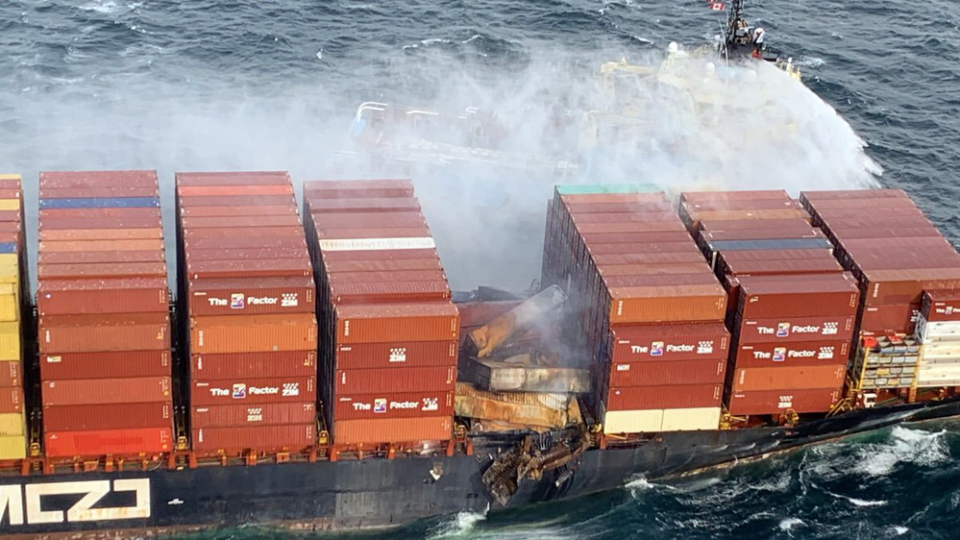Story by
Jim Heide
Tags /
- Cargo
- COVID-19
- Marine

Vessels not designed for rough seas. Insufficient fire fighting capacity. Increasingly severe weather. Container losses are on the rise today—and unprecedented consumer demand is throwing an accelerant on these already combustible conditions.
This weekend’s Zim Kingston incident provides just one more example of things going terrible wrong on the open water.
Listing to its side on rough seas, 40 containers plunged off the containership on Friday, according to the U.S. Coast Guard. On Saturday, the cargo ship’s woes continued as 10 containers—two of which contained the hazardous chemical, potassium amyl xanthate—caught fire.
While the fire was brought under control on Sunday, a “bomb cyclone” has complicated U.S. and Canadian coast guard attempts to track the 40 drifting containers, which now pose a threat to other ships—and heavy winds are expected tonight.
The Zim Kingston serves as another cautionary tale to shippers moving oceangoing cargo today—60-90% of which is transported under or uninsured.
Between 2008 and 2016, an average of 568 containers were lost at sea each year according to World Shipping Council reports. In 2020, that figure topped 3,000—and more than 1,000 containers were lost in just the early months of 2021.
What’s contributing to this elevated risk to marine cargo?
MEGA VESSELS BUILT FOR EFFICIENCY
Massive cargo ships constructed to address surges in demand have been built with efficiency in mind. While critical to reducing fuel costs and the industry’s carbon footprint, these streamlined vessels are at increased risk of parametric and synchronous rolling in rough seas. In combination with heavy winds and green water, this violent rolling can overwhelm cargo security systems—sending cargo containers overboard.
LACK OF FIREFIGHTING CAPACITY
Cargo vessels have grown significantly larger over the course of the last half-century. Meanwhile, the crews responsible for safely navigating these ships have been reduced to nearly a quarter, while firefighting hoses have just doubled, per an AGCS report.
Now consider the National Cargo Bureau’s study, which reported nearly 70% of import containers carrying dangerous goods were misdeclared, improperly labeled, or improperly secured and it becomes easy to understand why cargo fire risk aboard large containerships is elevated.
In fact, total losses resulting from fires and explosions at sea have reached a four-year high.
INCREASINGLY SEVERE STORMS AND ROUGH SEAS
Average global surface temperatures have increased more than 1 degree Celsius since the late 19th century, fueling increasingly severe storms—storms that are impacting maritime trade and presenting serious cause for concern within the insurance industry.
Now, cargo ships are increasingly forced to route around volatile weather, causing delays—though some, whether owing to a lack of modern weather routing tech or choosing to chance-it in the face of extreme supply chain pressures, remain on course—and at increased risk of encountering violent seas.
Further complicating matters, severe weather is no longer seasonal. “Year round we see tornadoes, hurricanes, floods and storms affecting shipping and inland marine, as well as associated infrastructure,” says Captain Andrew Kinsey, Senior Marine Risk Consultant at AGCS. “Almost every mode of transport is affected, with a knock-on effect for supply chains.”
The painful knock-on effects of marine container losses
As those with cargo aboard the Zim Kingston are soon to experience, the downstream impacts of container losses are far more painful than they were even just two years ago.
Those whose containers weren’t damaged in the Zim Kingston fire can expect a long delay before receiving their cargo. Worse, those whose cargo was lost will be unable to expedite replacement freight as capacity is simply nonexistent.
In a global economy that depends on just-in-time supply chains, these container losses in combination with COVID impacts, like factory slowdowns and worker shortages, mean interruptions that are driving up the cost of doing business—while driving some out of business altogether.